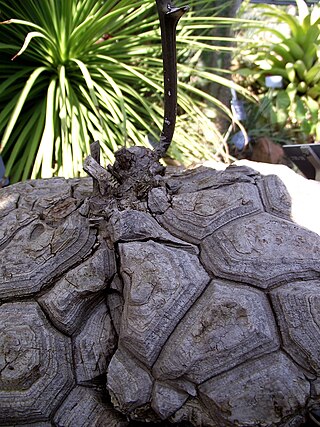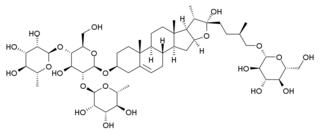
Progesterone (P4) is an endogenous steroid and progestogen sex hormone involved in the menstrual cycle, pregnancy, and embryogenesis of humans and other species. It belongs to a group of steroid hormones called the progestogens and is the major progestogen in the body. Progesterone has a variety of important functions in the body. It is also a crucial metabolic intermediate in the production of other endogenous steroids, including the sex hormones and the corticosteroids, and plays an important role in brain function as a neurosteroid.

Dioscorea villosa is a species of twining tuberous vine which is native to eastern North America. It is commonly known as wild yam, colic root, rheumatism root, devil's bones, and fourleaf yam. It is common and widespread in a range stretching from Texas and Florida north to Minnesota, Ontario and Massachusetts.

Yam is the common name for some plant species in the genus Dioscorea that form edible tubers. The tubers of some other species in the genus, such as D. communis, are toxic. Yams are perennial herbaceous vines cultivated for the consumption of their starchy tubers in many temperate and tropical regions, especially in West Africa, South America and the Caribbean, Asia, and Oceania. The tubers themselves, also called "yams", come in a variety of forms owing to numerous cultivars and related species.

Diosgenin, a phytosteroid sapogenin, is the product of hydrolysis by acids, strong bases, or enzymes of saponins, extracted from the tubers of Dioscorea wild yam species, such as the Kokoro. The sugar-free (aglycone) product of such hydrolysis, diosgenin is used for the commercial synthesis of cortisone, pregnenolone, progesterone, and other steroid products.

Dioscorea mexicana, Mexican yam or cabeza de negro is a species of yam in the genus Dioscorea.
The Marker degradation is a three-step synthetic route in steroid chemistry developed by American chemist Russell Earl Marker in 1938–1940. It is used for the production of cortisone and mammalian sex hormones from plant steroids, and established Mexico as a world center for steroid production in the years immediately after World War II. The discovery of the Marker degradation allowed the production of substantial quantities of steroid hormones for the first time, and was fundamental in the development of the contraceptive pill and corticosteroid anti-inflammatory drugs. In 1999, the American Chemical Society and the Sociedad Química de México named the route as an International Historic Chemical Landmark.

Sapogenins are aglycones of saponins, a large family of natural products. Sapogenins contain steroid or other triterpene frameworks as their key organic feature. For example, steroidal sapogenins such as tiggenin, neogitogenin, and tokorogenin have been isolated from the tubers of Chlorophytum arundinaceum. Some steroidal sapogenins can serve as a practical starting point for the semisynthesis of particular steroid hormones.

Protodioscin is a steroidal saponin compound found in a number of plant species, most notably in the Tribulus, TrigonellaDioscorea and Trillium families. It is best known as the putative active component of the herbal aphrodisiac plant Tribulus terrestris.

Sarsasapogenin is a steroidal sapogenin, that is the aglycosidic portion of a plant saponin. It is named after sarsaparilla, a family of climbing plants found in subtropical regions. It was one of the first sapogenins to be identified, and the first spirostan steroid to be identified as such. The identification of the spirostan structure, with its ketone spiro acetal functionality, was fundamental in the development of the Marker degradation, which allowed the industrial production of progesterone and other sex hormones from plant steroids.
Dioscorea composita, or barbasco, is a species of yam in the genus Dioscorea, native to Mexico. It is notable for its role in the production of diosgenin, which is a precursor for the synthesis of hormones such as progesterone. Russell Marker developed the extraction and manufacture of hormones from D. mexicana at Syntex, starting the trade of D. composita in Mexico. Marker also discovered that the composita variety had a much higher content of diosgenin than the mexicana variety, and therefore it came to replace the latter in the production of synthetic hormones.

The Mexican barbasco trade was the trade of the diosgenin-rich yam species Dioscorea mexicana, Dioscorea floribunda and Dioscorea composita which emerged in Mexico in the 1950s as part of the Mexican steroid industry. The trade consisted in Mexican campesinos harvesting the root in the jungle, selling it to middlemen who brought it to processing plants where the root was fermented and the diosgenin extracted and sold to pharmaceutical companies such as Syntex who used it to produce synthetic hormones.

Thinopyrum obtusiflorum is a species of grass known by the common names tall wheatgrass, rush wheatgrass, and Eurasian quackgrass. It is native to Eurasia and it has been introduced to many other parts of the world, including much of the Americas and Australia.
In molecular biology mir-326 microRNA is a short RNA molecule. MicroRNAs function to regulate the expression levels of other genes by several mechanisms.
Triticum urartu, also known as red wild einkorn wheat, and a form of einkorn wheat, is a grass species related to wheat, and native to western Asia. It is a diploid species whose genome is the A genome of the allopolyploid hexaploid bread wheat Triticum aestivum, which has genomes AABBDD.
Penicillium decumbens is an anamorph species of the genus of Penicillium which occurs widespread in nature, mainly in subtropical and tropical soil but it also occur in food. Analysis have shown that Penicillium decumbens has antibiotic activity Penicillium decumbens produces the cyclopentenone cyclopenicillone

Li Jiayang is a Chinese agronomist and geneticist. He is Vice Minister of Agriculture in China and President of the Chinese Academy of Agricultural Sciences (CAAS). He is also Professor and Principal investigator at the Institute of Genetics and Development at the Chinese Academy of Sciences (CAS).

RU-59063 is a nonsteroidal androgen or selective androgen receptor modulator (SARM) which was first described in 1994 and was never marketed. It was originally thought to be a potent antiandrogen, but subsequent research found that it actually possesses dose-dependent androgenic activity, albeit with lower efficacy than dihydrotestosterone (DHT). The drug is an N-substituted arylthiohydantoin and was derived from the first-generation nonsteroidal antiandrogen (NSAA) nilutamide. The second-generation NSAAs enzalutamide, RD-162, and apalutamide were derived from RU-59063.
Dioscorea althaeoides is a herbaceous vine in the genus Dioscorea which is indigenous to the Guizhou, Sichuan, and eastern Xizang provinces of China, in addition to the Yunnan area in Thailand. A formerly unknown acetylated spirostanol saponin, dioscin-6′-O-acetate, has been discovered in the rhizomes of the plant.
Kang Zhang is a Chinese-American ophthalmologist specializing in ophthalmic genetics and aging processes in the eye. He is currently a Professor of the Faculty of Medicine at Macau University of Science and Technology. He was previously a Professor of Ophthalmology and the Founding Director of the Institute for Genomic Medicine at the University of California, San Diego. Zhang is particularly known for his work on lanosterol, stem cell research, gene editing, and artificial intelligence.










